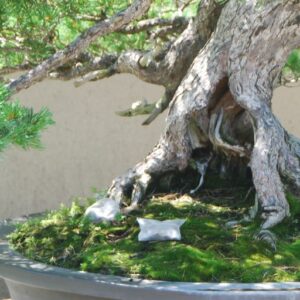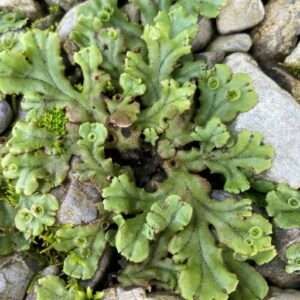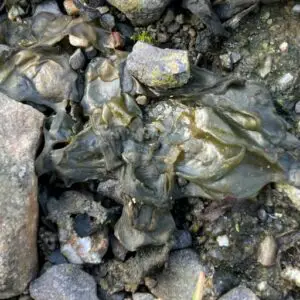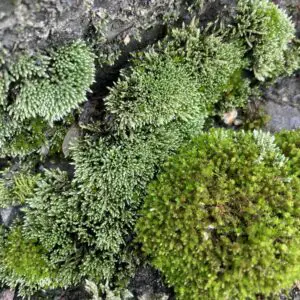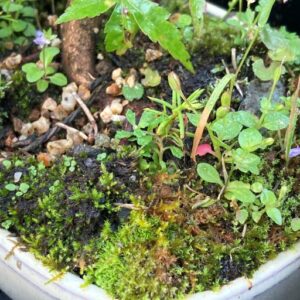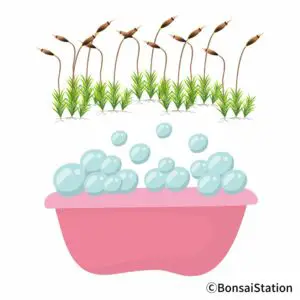Not all moss is good for bonsai. A good bonsai moss has to be small in height, grow together in a lump, and grow without special care.
Can you use any type of moss for bonsai?
Features for good bonsai moss
Not every moss is good for bonsai. There are a few features that have to be met in order for the moss to be used in bonsai. Good bonsai moss has to;
- be small in height,
- grow together in a lump, and
- grow without special care.
Small in height
Bonsai moss should be relatively small in height and not so conspicuous. If it is too large or tall, bonsai trees do not look like fully-grown trees in nature. There are kinds of moss that grow a few inches tall, which are good for moss terrarium, but not suitable as bonsai moss.
Grow together in a lump
The kind of moss that gather together in a lump and bind the soil is good bonsai moss. The moss can help retain water and stop the soil in the pot from flowing out.
Grow without special care
Bonsai moss should not need special care separate from your bonsai trees. It should be cared for at the same time when you care for your bonsai trees. In that matter, photophilic moss species (those that grow well under the sun) are preferable since bonsai trees need lots of sunlight.
What is bad bonsai moss?
There are some kinds of moss that you should avoid for bonsai moss. You do not want to use moss that;
- covers the soil like a carpet,
- does not look good with bonsai tree, and
- can hurt the bonsai tree’s health.
Covers soil
Moss that crawls the ground like a carpet does not make a good bonsai moss. This kind of moss begins to cover the surface roots and trunk, once it covers the soil. The surface roots and the trunk of bonsai trees should stay dry, not moist.
Brachythecium moss, for example, is a large moss, growing in lax, glossy patches. It looks beautiful with its bright green color but is not ideal for bonsai moss.
Does not look good
Liverworts like marchantia polymorpha are dull green or brown in color and quite large. Besides the fact that they grow on shaded moist soil in damp habitats, which is not desirable for bonsai trees, they look bad on bonsai.
Bad for bonsai tree health
Organisms like nostoc commune can harm bonsai tree growth. Nostoc commune is dull, dark green, jelly-like organism that is commonly seen after rain. Not only does it look bad but it also lives in symbiosis with fungi and bacteria. It is not directly hazardous to bonsai trees but it can completely cover the soil like a blob, keeping the soil very wet. It sometimes smells bad as well.
Best bonsai moss
The top recommendation for bonsai moss is silver moss (Bryum argenteum) and other moss in the Bryum family because;
- they are short and their color matches bonsai trees;
- they grow together densely and hold water and soil well;
- they can tolerate heat and cold;
- they can be found anywhere near human habitat for free; and
- they do not need special care.
For more about which bonsai moss to choose from, please read the following post.
Can you use moss from outside for bonsai?
You can use moss from outside for bonsai. There are, however, a few things to consider and do besides its fitness as a good bonsai moss.
Things to consider
As mentioned earlier, good bonsai moss has to;
- be small in height,
- grow together in a lump, and
- grow without special care.
It would be best if you avoided the moss that;
- covers the soil like a carpet,
- does not look good, and
- that can hurt the bonsai tree’s health.
When picking the moss outside, you should think about the environment that you are transferring it to, the place you put your bonsai trees.
There are so many kinds of moss in the world and different types of moss prefer different environments. Some are suitable for bonsai and some are not. Moss that you found in the woods might not survive in your backyard where you place your bonsai trees.
When picking moss outside, you will need to provide the moss with similar conditions as your bonsai tree for it to grow and stay green. If you have juniper, spruce, oak, maple or cherry bonsai, they love sunlight and should be kept outside where they can have direct sunlight at least a few hours a day.
Bonsai moss for these bonsai trees has to have a high tolerance to strong sunlight and drought. The wrong kind of moss will not grow well even if you transfer it to the bonsai soil in the right way.
Clean the moss before you transfer
Why clean the moss
There are things to do before you transfer the moss you found to your bonsai. You cannot pick the moss somewhere and transfer it directly to your bonsai without cleaning it.
If you look closely underneath the moss that grows naturally, you will find that it is full of small insects/worms, dead leaves and dead twigs. You might think there are not any of these since not many insects feed on moss. But there are!
Many insects and worms are in moss as a hideout or home, not as a food source. Moss has many advantages for small creatures, such as maintaining constant humidity and having many small gaps that make it difficult for their enemies to attack.
If you transfer the moss you picked outside to your bonsai without cleaning, insects, debris and seeds will be transferred to your bonsai tree along with it. Insect droppings cause mold to grow, and some insects may eat bonsai leaves. Dead leaves and twigs can also cause mold. Seeds will spawn and take roots in the bonsai pots.
Before transferring the moss to the bonsai, therefore, you must wash it thoroughly to remove these insects and debris.
How to clean the moss
Wash with running water
One way to clean the moss is to wash it with running water.
- Break the moss into manageable pieces and pour running water (preferably shower) on the moss.
- Gently press it with your fingers from every side to identify and remove any foreign objects (insects, worms, bits of leaves/twigs, or seeds).
- Keep washing until you remove them all.
Submerge in the water
Another method is to fill a bucket or container with clean water and submerge the moss.
- Squeeze the moss gently under the water, taking time to swirl them around. You want to clean off as much dirt and debris as possible.
- Leave the moss submerged for a couple of hours to a day or two, depending on the species. Most moss can be in the water for some time as long as it has sunlight. Insects lurking in it will run out of oxygen and come out of the moss by themselves. Debris that was not removed then will float.
- You might want to put a weight on the moss to sink it if it floats.
Once the insects and debris in the moss are removed, you can take out the moss to transfer to the bonsai.
How do you transfer moss to bonsai?
There are two ways to transfer the moss you picked outside to your bonsai.
- Transfer the chunk
- Sprinkle the moss
Method 1: Transfer method
- After cleaning the moss, lay the chunks of moss flat on the surface of the soil, root-side down.
- Press the moss gently but firmly into the soil so that it will go into the soil a little. You do not need to dig a hole for it to sit in.
- From around the moss, push the soil towards the moss so that the center of the moss is slightly raised.
- If you have multiple pieces of moss, spread them out. The moss will naturally spread and grow to fill in gaps over time.
- Water the soil and the moss well until the moss grabs the soil.
Method 2: Sprinkle method
- Break the moss into small pieces with your hands.
- Put the pieces of moss and bonsai soil (akadama is good) in a bucket or container and mix them well.
- Sprinkle the mixture of the moss and soil on the bonsai soil about an inch (1.5cm) deep, up to a third of the surface of the pot. Press the mixture gently to sit it in.
- Mist the soil well so that the moss/soil mixture does not dry until the moss will grow back in about a month.
- If you live in a dry climate, covering the mixture with a plastic bag (not the entire bonsai soil) is a good idea.
If the moss is not doing well, the following post may help.


